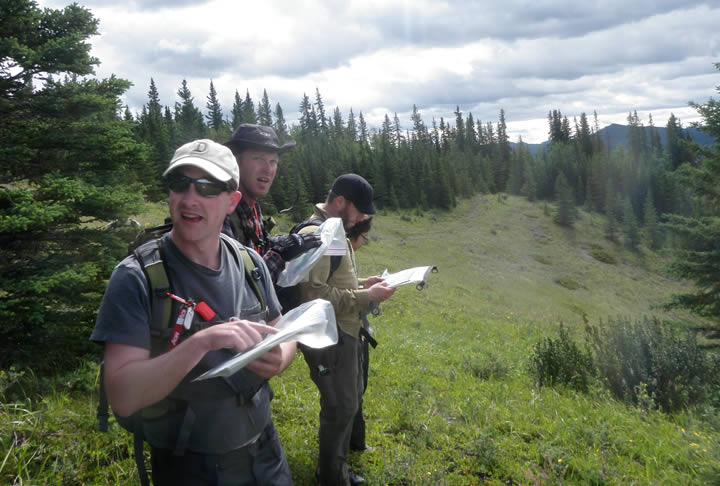Don't Give up the Freedom to Travel
Many People Find Learning to use the Navigator’s Toolbelt (Magnetic Compass, Topographical Map, and a GPS Receiver) a Complex Undertaking, especially without Proper Instruction. Unfortunately, this means that people travel into the Wilderness without Training. Wilderness Navigation is an Easy and Straightforward subject when Explained, Demonstrated, & Practiced Correctly. Learning to use these Navigation Tools allows you the Freedom to Safely Travel into the Wilderness.
“In the wilderness, most navigation mistakes are avoidable with basic navigation training”

What are the Top 3 Avoidable Mistakes in Wilderness Travel? No Route Planning or Route Card, No Rescue Plan or Escape Route, & Not Understanding how to use the Navigator’s Toolbelt. Let’s take a look at each of these 3 Common Errors:
No Route Planning or Route Card
Basic route planning is forgotten time and time again by those who travel into the wilderness. A Search and Rescue Operation can cost thousands of dollars, consuming hundreds of hours of both professional and volunteers search time in a multi-day ground and air search. Take time before you travel into the wilderness to plan your route, understand the obstacles and hazards that may be found along the way.
“You can’t fill out a route card after you’ve gone into the wilderness.”
Route Cards make planning your route simple and straightforward. Take the time and fill in your Route Card, then give a copy to everyone in your group, and leave a copy with someone you trust to initiate your rescue plan. By creating a route plan and filling in a basic Route Card you can avoid the need for a search and/or lessen the time that any search will take.
No Rescue Plan or Escape Route
When you travel into the wilderness without a proper rescue plan or escape route you put your life in unnecessary danger. An escape route is a simple bearing towards a major highway, road or other linear feature.
“The bearing of your escape route could save the life of you or one of your travelling companions”
Everyone you travel with must have a compass and an understanding of how to use it in an emergency. Each individual in a group must know the bearing of their escape route and why this route was chosen. They must also have a basic understanding of the geography of the area so they are not dawning off course by the ground or channelled in the wrong direction as they are travelling towards safety.
Not Understanding How to Use the Navigator’s Toolbelt
Again and again, people walk through the door of my classroom after getting lost or geographically displaced in the wilderness. GPS salesmen and brochures are culpable in pushing GPS Receivers as the 'one tool' you need for wilderness navigation instead of part of the Navigator’s Toolbelt.
Few people know how to use a compass or read a topographical map. Many individuals simply carry a compass, along with rough trail descriptions and think that’s enough. If you cannot use your tools to help you along the way they’re useless. Often crude small-scale maps are taken instead of the air photos and the large-scale topographical maps necessary for proper wilderness navigation.
“When you are lost is not the time to finely learn how to use your compass”
Basic navigation skills take time to explain. Proper navigation techniques take time to master. You need to spend more than just a few hours learning these skills and techniques. Navigator’s Toolbelt is not limited to the three basic tools.
Like a good carpenter, a good navigator will add additional tools to their Toolbelt as they learn new techniques. Air photos, an altimeter, GPS maps, pace beads, and time estimation can all be useful to help you travel safely in the wilderness and are great additions to your Toolbelt.
Proper Wilderness Navigation Instruction
Imagine the satisfaction of getting to a mountain lake that has no trail to it. Proper wilderness navigation training is all about restoring that freedom lost to poor basic navigation skills. I cannot imagine travelling without the freedom to depart the trails, travel the less trodden paths, and see the real backcountry.
“…the skills taught progressively take you from knowing next to nothing to being confident in wilderness navigation.”
— Complete Wilderness Navigation Graduate
This is the year to spend time mastering Wilderness Navigation. When you complete any professional wilderness navigation course you will be more confident and knowledgeable. The first step of the journey is to supplement your present navigation skills with additional practical skills and build up a proper knowledge base.
Here at BWI, we offer 2 Ways to Get Started on that Journey. First the 5-Days standalone Complete Wilderness Navigation (CWN) or if you only have 1-Day to start your training then the Navigation Core Seminar (NCS).
“Skills gained gave me the confidence to go out to the backcountry alone…”
— Complete Wilderness Navigation Graduate
Don't Give up Your Freedom to Travel into and out of the Wilderness Safely. Come join us for a Real Outdoor Education because Professional Wilderness Navigation Training is a Necessary Lifelong Investment.
Additional Navigation Resources
- Complete Wilderness Navigation [5-Days, Includes GPS Training]
- Navigation Core Seminar [7-Hours, Includes GPS Training]
- Wilderness Navigators Tool Belt [Article]
- Build Your Own Pace Beads [Article]
- Compass Hints [Article]
- GPS Receiver Part of the Navigators Toolbelt [Article]
- Navigation & Orienteering Resources

